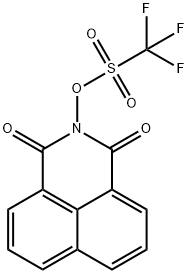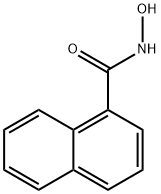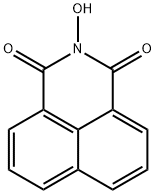N-Hydroxynaphthalimide triflate
- CAS NO.:85342-62-7
- Empirical Formula: C13H6F3NO5S
- Molecular Weight: 345.25
- MDL number: MFCD02683478
- EINECS: 233-299-3
- SAFETY DATA SHEET (SDS)
- Update Date: 2024-11-04 13:44:46

What is N-Hydroxynaphthalimide triflate?
Chemical properties
N-Hydroxynaphthalimide triflate is a low molecular weight compound with the appearance of white to light yellow powder to crystal, melting point is 212.1~214.2 °C, boiling point is 456.2±55.0 °C, density is 1.76±0.1 g/cm3, maximum absorption wavelength is 365(CH3CN) nm. It is sensitive to light and moisture and is normally stored under inert gas.
The Uses of N-Hydroxynaphthalimide triflate
HNT can be used to form patterned nanoparticles that find potential applications in volumetric manufacturing of semiconductor devices. It can also be used in the photo-responsive pore reopening of zeolites that facilitates the regulation of the gas permeation process. UV-irradiated trimethylsilyl ultrathin cellulose based films can be formed in presence of HNT as a PAG.
What are the applications of Application
N-Hydroxynaphthalimide triflate is a cationic photoinitiator and nonionic photoacid generator
What are the applications of Application
N-Hydroxynaphthalimide triflate is a cationic photoinitiator and nonionic photoacid generator used for polymer science, contact printing, and self-assembled monolayers (SAMs).
General Description
N-Hydroxynaphthalimide triflate (HNT) is a photoacid generator(PAG) that forms an acid upon exposure to UV light which can be used to generate patterned structures. It can also be used to tune the solubility of a polymer by forming acid linkages.
Properties of N-Hydroxynaphthalimide triflate
| Melting point: | 212.1-214.2 °C |
| Boiling point: | 456.2±55.0 °C(Predicted) |
| Density | 1.76±0.1 g/cm3(Predicted) |
| storage temp. | 2-8°C |
| solubility | PGMEA: 1% |
| form | powder to crystal |
| color | White to Light yellow |
| CAS DataBase Reference | 85342-62-7 |
Safety information for N-Hydroxynaphthalimide triflate
| Signal word | Warning |
| Pictogram(s) |
 Exclamation Mark Irritant GHS07 |
| GHS Hazard Statements |
H302:Acute toxicity,oral H315:Skin corrosion/irritation H319:Serious eye damage/eye irritation H335:Specific target organ toxicity, single exposure;Respiratory tract irritation |
| Precautionary Statement Codes |
P261:Avoid breathing dust/fume/gas/mist/vapours/spray. P305+P351+P338:IF IN EYES: Rinse cautiously with water for several minutes. Remove contact lenses, if present and easy to do. Continuerinsing. |
Computed Descriptors for N-Hydroxynaphthalimide triflate
| InChIKey | LWHOMMCIJIJIGV-UHFFFAOYSA-N |
New Products
4-Fluorophenylacetic acid 4-Methylphenylacetic acid N-Boc-D-alaninol N-BOC-D/L-ALANINOL Tert-butyl bis(2-chloroethyl)carbamate 3-Morpholino-1-(4-nitrophenyl)-5,6-dihydropyridin- 2(1H)-one Furan-2,5-Dicarboxylic Acid Tropic acid S-2-CHLORO PROPIONIC ACID ETHYL ISOCYANOACETATE 2-Bromo-1,3-Bis(Dimethylamino)Trimethinium Hexafluorophosphate (6-METHYL-[1,3]DITHIOLO[4,5-b]QUINOXALIN-2-ONE INDAZOLE-3-CARBOXYLIC ACID 4-IODO BENZOIC ACID (2-Hydroxyphenyl)acetonitrile 4-Bromopyrazole 5,6-Dimethoxyindanone 2-(Cyanocyclohexyl)acetic acid 4-methoxy-3,5-dinitropyridine 2-aminopropyl benzoate hydrochloride 1-(4-(aminomethyl)benzyl)urea hydrochloride diethyl 2-(2-((tertbutoxycarbonyl)amino) ethyl)malonate tert-butyl 4- (ureidomethyl)benzylcarbamate Ethyl-2-chloro((4-methoxyphenyl)hydrazono)acetateRelated products of tetrahydrofuran




You may like
-
 N-Hydroxynaphthalimide triflate 95% CAS 85342-62-7View Details
N-Hydroxynaphthalimide triflate 95% CAS 85342-62-7View Details
85342-62-7 -
 N-Hydroxynaphthalimide Trifluoromethanesulfonate CAS 85342-62-7View Details
N-Hydroxynaphthalimide Trifluoromethanesulfonate CAS 85342-62-7View Details
85342-62-7 -
 1975-50-4 98%View Details
1975-50-4 98%View Details
1975-50-4 -
 2-HYDROXY BENZYL ALCOHOL 98%View Details
2-HYDROXY BENZYL ALCOHOL 98%View Details
90-01-7 -
 2-Chloro-1,3-Bis(Dimethylamino)Trimethinium Hexafluorophosphate 221615-75-4 98%View Details
2-Chloro-1,3-Bis(Dimethylamino)Trimethinium Hexafluorophosphate 221615-75-4 98%View Details
221615-75-4 -
 61397-56-6 CIS BROMO BENZOATE 98%View Details
61397-56-6 CIS BROMO BENZOATE 98%View Details
61397-56-6 -
 14714-50-2 (2-Hydroxyphenyl)acetonitrile 98+View Details
14714-50-2 (2-Hydroxyphenyl)acetonitrile 98+View Details
14714-50-2 -
 118753-70-1 98+View Details
118753-70-1 98+View Details
118753-70-1